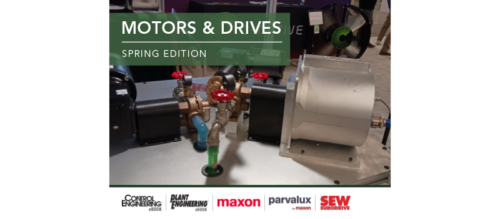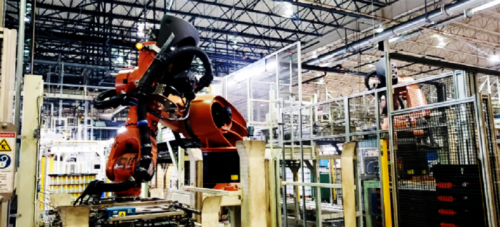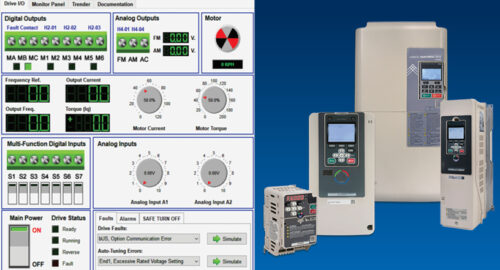The possibilities, limits of VFDs
The scope of product use has expanded beyond energy efficiency.
Variable frequency drives, inverters, drives, and variable speed drives are all terms that in common industrial usage today imply an electronic control unit that can be used to vary the speed or torque delivered by a motor. While most new variable speed applications today use either induction, permanent magnet AC (PM), or Switched Reluctance (SR) motors, we will ignore these technology differences for the purpose of this article; each technology has its benefits and strengths.
This article will start with basic concepts and describe a couple of examples that relate some of the major challenges in applying variable speed for energy savings.
The limits of VFDs
We begin with an important point: Variable frequency drives do not make motors more efficient. If anything, the losses of a VFD add to the basic motor losses (due to harmonics; i.e., since the waveforms delivered by a VFD to the motor are not perfectly sinusoidal, there is additional heating of the motor). Also, most motors have lower efficiencies when their speed deviates from a “base” speed. And yet, VFDs can help make an overall application, system, or process more energy efficient than without them.
While VFDs are now widely used in industry, utilities, and even residential applications, there has also been misperception at the management level as to how these investments in upgrades actually work.
VFDs can be used to save energy by controlling the speed of motors in several applications or processes. In addition to the energy savings delivered, use of VFDs can also lead to savings from better machinery or equipment uptime, lower switchgear and cabling costs, better process control, and therefore higher productivity, quality, and the like.
An analogy for use of motors without VFDs would be like driving a car with the gas-pedal floored and then controlling speed using only the brake. That results in using a lot of gas, an uneven ride, worn brake pads, and a short engine life. That may sound like a ridiculous way of running any machine. But until VFDs became economical, reliable, and user-friendly, that is how most motors were run—the outputs were throttled, braked, “slipped” in clutches, or bypassed (in the case of fluid pumping).
While the gas pedal does not make your car’s engine any more efficient, the fact that you have a gas pedal allows better mileage, less overall wear, and better rides than if you did not have one and relied on the brake alone. The gas pedal describes best what a VFD can do for your process or equipment.
Now imagine that your car rides are only on long, open roads with no speed limits. You might as well floor the gas and get to your destinations as soon as possible; in this case, if installing a gas pedal cost a lot, you might as well leave it out and just use the ignition to go and stop. This can be the case with some motor applications where the process needs either all of the motor’s output or none at all—grinding wheels, table saws, coolant pumps, etc. often fit this description.
Many applications can benefit from controlled speeds even when this benefit is not predominantly energy saving. While an elevator ride could be accomplished at fixed speed, the smooth ramp-up and ramp-down of speed provide a comfortable ride; here the process is improved to deliver a higher quality ride.
Another example would be some extruders that could run at fixed (uncontrolled) speed but variations in line voltage or frequency will impact screw speed and therefore product geometry; that is, while a VFD may not save much energy in this application, the control and speed regulation would result in higher quality output.
In the early years, variable speed drives were primarily DC and were used solely for the purpose of machine control—paper plants, rolling mills, extruders, etc. used drives to control motor speeds and torques in order to manage line speed and process variables like thickness, grain formation, and winding tightness.
While process control still remains a major reason for use of variable speed drives in industry, the scope of VFD usage has dramatically widened to applications that were previously run at fixed speed; the overwhelming reason for use of variable speed in these applications is to save energy and reduce operating costs. The driving forces for this wide-scale adoption of variable speed technologies are the increase in energy costs, reduction in the cost of drives, enhancement in technology, and ease-of-use. Lastly, the prevalence of drives has made users more accepting of these devices in even newer and more creative applications.
Previous fixed-speed applications are now using variable speed to deliver significant energy and other operational cost savings. These savings also occur when traditional mechanical-speed controls like fluid couplings, gear-shifting, and eddy-current clutches are replaced with direct-driven, VFD-controlled motors. These conversions from fixed to variable speed applications fall into several categories. We will describe two categories in particular: pumps and fans, and compressors.
Pumps and fans
A 2002 U.S. Dept. of Energy study estimated that approximately 24.8% of industrial “motor system” energy usage was for pumps and another 13.7% for fans. Traditionally, liquid or air flow from a pump or blower was commonly controlled with throttle valves, vanes, or bypass mechanisms.
If the process demanded less flow than that delivered by the pump or blower, the flow was either or redirected/bypassed elsewhere. The motor operation was left relatively unchanged by running the pump or blower at a fixed speed while manipulating the output to match the process. Examples of such applications are cooling tower fans, process feed pumps, heat exchanger circulator pumps, and induced draft fans.
These centrifugal pump, fan, or blower applications are particularly attractive for conversion to variable speed—this is because of the “affinity laws” that define the relationship between speed, flow, head, and power.
In a centrifugal pump (or fan), while the flow rate is directly proportional to speed, the power required is proportional to the cube of speed; that is, if the flow is reduced by a third by slowing down the pump, you reduce the power consumption to (not “by”) 30%—a 70% reduction in power used. It is a profound relationship when converted to dollars of energy that can be saved.
The use of variable speed has also allowed pump users to exploit smart benefits and solve old problems; water hammer, cavitation, shaft shear at starting, and more can all be mitigated once running the motor with variable speed. The use of a controlled speed on pumps (or blowers) also allows users to eliminate control valves and vanes. This reduction in moving parts translates into higher system reliability and lower failure rates.
Compressors
The same 2002 U.S. Dept. of Energy study referenced above estimates the energy consumption of motor systems for compressed air at 15.8% as a percentage of all industrial motor systems. Irrespective of the type of compressor, whether positive displacement (reciprocating or rotary) or dynamic (centrifugal or axial), is the norm for most plants. While plant engineers have always worked with and creatively tackled issues such as compressor location, distribution line drops, pressure drop in air filters, and segregation of high- and low-pressure requirements to minimize energy consumption, never before did they have as much flexibility in matching delivery pressure by compressor modulation as with the advent of variable speed systems.
This approach of tightly controlling the delivery pressure within a very narrow band close to the “required” pressure offers very significant energy savings. The alternative is to maintain accumulator pressure well in excess of the required/application pressure to compensate for pneumatic load variability and line losses. This is poor in terms of energy consumption. For example, operating a system at 120 psig instead of 100 psig requires 10% more energy; in addition, the higher pressure leads to higher line losses due to leakage.
Variable speed systems allow air compressors to manage the delivery pressure precisely and deliver exactly what is needed for the application while compensating for line losses and coping with the variability of demand. If several compressors feed into a single header, it is common to see several units run at fixed speed delivering the base or minimum load while a variable speed unit caters to the process variation. This arrangement often makes most economical sense.
Variable speed technologies also pose several challenges to the design or plant engineer. Do I use motor efficiency as a basis for comparison? Is system efficiency the most critical parameter? If so, system efficiency at what operating point? What does a variable speed system do to my power quality, and at what operating points?
Unfortunately, the motor-systems world is still grappling with these issues and trying to define test protocols and standards. These are all issues that currently require a solid understanding of application, motor-equipment matching, and equipment-specific engineering.
Aloor is director of business development for the Nidec Motor Corporation.
Do you have experience and expertise with the topics mentioned in this content? You should consider contributing to our CFE Media editorial team and getting the recognition you and your company deserve. Click here to start this process.





